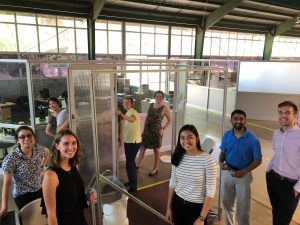Staring out the autobus window watching the rain stream down the window and billboards flying by advertising Copa Mundial-themed products, I reflected on events of the past few days. We’ve spent three days in Costa Rica so far, each packed with learning about needs finding for engineering, traveling, and learning about Costa Rican culture. However, as we drove back to our apartotel, I kept puzzling over the same thought. Earlier while listening to a doctor at Liberia Hospital describe patient limitations with performing peritoneal dialysis independently at home, a brief thought flashed through my mind: “Patient noncompliance is a big issue not just in the United States. No surprise there.” I shrugged it off, but then I kept thinking about it during each activity that we did afterward. And then I began to think deeper about why.
Here is where we turn our “engineering brain off and social science brain on”, a mindset Dr. Richardson asked us to uphold through Tuesday. It’s instinctual to dive headfirst into coming up with solutions without defining the scope of the problem and identifying root causes, so we’re encouraged to think broadly as we think about our projects’ need statements.
Patient compliance can be defined as how closely a patient correctly follows medical advice, for example taking medications, using personal medical devices, and physical therapy. The advice is intended to help the patient feel better, recover, etc., so why wouldn’t patients want to comply if the results are so beneficial? What if they don’t want to? Or if the administration and side effects cause discomfort? Or if it seems like the advice isn’t making a difference? Or if it’s too expensive? Or they can’t read? Or they can’t understand or remember complicated instructions, a common oversight in medical procedures expected to be performed by patients (these are called “pain points”)?Obviously, healthcare providers can’t force patients to do anything, which is frustrating, but in the end, it’s up to the patient to follow their provider’s plan. Can patients be motivated to comply by making x more enjoyable, easier to understand, etc.?
Part of the engineer’s job in designing a successful medical device is to identify the cause of why patients aren’t following medical advice and come up with solutions. For example, thorough handwashing for five minutes is a seemingly simple but frequently overlooked step prior to performing peritoneal dialysis at home. Skipping this step puts the patient at risk for contracting peritonitis, an infection of the peritoneum. Started by last year’s GMI team, the DialOasis (affectionately called a “cuartito”) is a tiny room-like structure that allows patients with chronic kidney disease to perform dialysis in a clean, safe environment at home, reducing frequent hospital visits and increasing quality of life (more time with family, work, etc.). As an exercise, we were given only half an hour to assemble the DialOasis and then we analyzed its design strengths and weaknesses. This activity in conjunction with talking to the doctor at Liberia got us thinking about how to address the hand washing issue, starting with what its causes may be. Some highlights:
- 5 minutes is a long time to wash hands. Most people can’t even get through the Happy Birthday song twice. Actively doing mundane tasks = boring and easy to cut short.
- Requires lots of clean water
- Easy to forget this step if not habitual
Attempting to assemble the cuartito at Universidad Invenio
In addition to the DialOasis, we’re splitting up into groups this week for a short course with Costa Rican students. Sylvie and I will be tackling “a way to facilitate flossing in the elderly in order to improve gum care”. Do you floss routinely and properly? Exactly. Now imagine how much harder it is to perform regularly if you have physical or mental limitations, in conjunction with being in a phase of life when gum health and care are not only more essential but also more difficult because of dental bridges, implants, etc. I’m looking forward to seeing what our team will come up with in this short amount of time.
———
Three first impressions for the first three days:
- Mountains!! I’ve exclusively lived in really flat regions of the U.S., so seeing lights on an incline at night, winding, steep roads, and large mountains in the distance is just wild to me and will probably never get old.
- I got to experience watching a real fútbol match! It was really exciting, high energy, and a great cultural experience.
- Food: gallo pinto is the best dish I’ve had so far, and in my opinion is better than any fancier, modern restaurants we’ve been to. I would love to eat it every day, but there are no sodas close to the apartotel.
 Apparently, the south end where we sat is the rowdy end.
Apparently, the south end where we sat is the rowdy end.
Bonus: Week 1 Exotic Fruit Bingo – Guanábana (soursop): I had this as a juice and smoothie, but also found it in yogurt and ice cream forms. I’d describe the taste as sweet, mild, and a little acidic like pineapple. It’s super refreshing.

